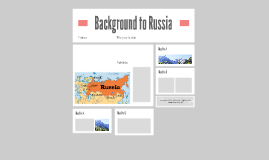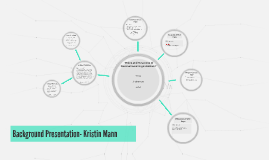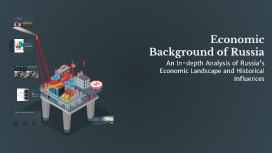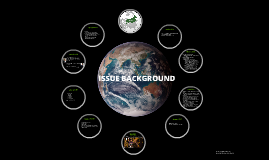Economic Background of Russia
Transcript: Challenges Facing the Russian Economy The Russian economy is currently grappling with a range of significant challenges. Economic sanctions imposed by various countries have restricted trade and investment, hindering growth. Furthermore, the need for economic diversification remains critical as the country heavily relies on oil and gas exports. Demographic issues, such as an aging population and declining workforce, also pose long-term risks to economic stability and growth. Major Exporter of Natural Resources Russia is one of the world's largest exporters of natural resources, particularly oil and gas, which significantly influences its foreign trade dynamics. Key Trading Partners China, the European Union, and the United States are among Russia's top trading partners, with China being the largest, accounting for a substantial portion of its trade volume. Foreign Trade and Investment Economic Background of Russia Fluctuating Foreign Direct Investment Foreign direct investment (FDI) in Russia has seen fluctuations due to geopolitical tensions, which impacts the overall economic stability and growth prospects. Need for Economic Diversification Investment in technology and infrastructure is essential for Russia’s economic diversification and growth, attracting foreign capital into various sectors beyond energy. Energy Sector: A Global Leader Manufacturing and Agriculture: Diversifying the Economy The energy sector is the backbone of the Russian economy, contributing significantly to GDP and export revenues. Russia is one of the world's largest producers of oil and natural gas, with significant reserves that fuel its economy and influence global energy markets. Manufacturing is diverse, encompassing machinery, automotive, and aerospace industries. While it contributes less to GDP than energy, it plays a crucial role in job creation and economic diversification. Additionally, agriculture remains vital, producing grains, potatoes, and livestock, ensuring food security and export opportunities. An In-depth Analysis of Russia's Economic Landscape and Historical Influences GDP Growth Rate: 1.5% As of 2023, Russia's GDP growth rate stands at approximately 1.5%, reflecting slow recovery amid ongoing international sanctions and geopolitical tensions. Inflation Rate: 6% Key Economic Indicators The inflation rate in Russia has been fluctuating around 6%, driven by supply chain disruptions and changes in consumer demand resulting from economic sanctions. Unemployment Rate: 4.5% Currently, the unemployment rate in Russia is approximately 4.5%, indicating a relatively stable job market despite the economic challenges the country faces. Historical Overview of Russia's Economic System A chronological exploration of key milestones in Russia's economic evolution from the Soviet Union to the modern era. Russia's Economic Significance and Distinctiveness 1991 2023 2000 1917 The collapse of the Soviet Union marks a transition to a market economy, characterized by privatization and deregulation. Current focus on economic diversification and resilience against external pressures, with a push for innovation in various sectors. Vladimir Putin's presidency begins, leading to economic stabilization and growth driven by rising oil prices. The Bolshevik Revolution leads to the establishment of a socialist economy, nationalizing industries and collectivizing agriculture. 1928 2020 Russia holds a pivotal position in the global economy, recognized for its vast natural resources, particularly in energy sectors like oil and gas. Its economic landscape is characterized by state involvement in key industries, a mix of planned and market-driven approaches, and a need for diversification to foster sustainable growth. Understanding these elements is vital for comprehending Russia's role in international trade and finance. The first Five-Year Plan is implemented, focusing on rapid industrialization and central planning in the economy. The Russian economy faces challenges due to sanctions and the COVID-19 pandemic, impacting growth.

















